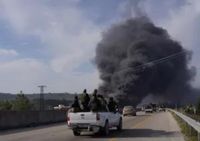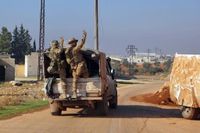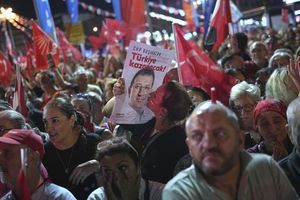Damascus, Syria - The presence of foreign fighters in Syria has taken on new complexities as their involvement in the downfall of Assad's regime during December 2024 has become a major challenge for the new administration in Damascus. Opinions are sharply divided between calls to integrate these fighters into local communities and calls to deny them any formal status within the security and military institutions, especially after the Ministry of Defense announced plans to grant military ranks to some of them. This decision is based on the belief that these individuals have sacrificed for the liberation of the Syrian people and are committed to the administration’s policies, coupled with assurances that their presence won’t pose any risk to friendly nations.
The landscape of foreign fighters in northwestern Syria is dominated by Hay'at Tahrir al-Sham, which holds the majority of the foreign combatants. Although there are no precise official statistics, estimates indicate that around 2,500 foreign fighters continue to operate under its umbrella. These fighters chose to remain with Hay'at after it severed ties with al-Qaeda in 2016, opting for local jihadist strategies instead of the global jihadism that characterized earlier foreign involvement.
Despite a reduced conversation about the foreign fighter phenomenon in recent years, it has resurfaced recently, particularly in light of recent accusations that some members have been involved in civilian casualties during events on the Syrian coast. The U.S. government has taken an active interest, condemning claims of their involvement in murders. "The United States condemns the extremist Islamic leaders, including foreign jihadists, for carrying out acts of killing in western Syria in recent days," the U.S. Department of State stated on its X platform.
Although foreign fighters make up only a small fraction of the new Syrian Army's overall combat force, their presence continues to complicate the military balance. Predominantly non-Syrian, these fighters come from diverse backgrounds, including Egyptians, Europeans, Chechens, Uzbeks, Tajiks, and Kazakhs. Their numbers and ideological transformations signal a significant shift as they align with local objectives against the ruling regime rather than pursuing global jihad.
The Turkistani Islamic Party, consisting of seasoned fighters from China's East Turkestan, stands out as a prominent faction among the foreign fighters. They have adjusted their approach in Syria and are not perceived as a threat by the Assad government, with the Turkish connection smoothing their acceptance. In a 2020 interview, Syrian President Ahmed al-Shar'a pointed out that the Turkistani fighters do not pose a danger to the outside world; they are primarily defending Idlib against regime attacks and thus deserve a degree of support.
As foreign fighters are absorbed into the military structure, some now occupy high-ranking positions within Syria’s Ministry of Defense, such as Aziz Daoud Khadabardi, an Uyghur brigadier. President al-Shar'a noted, "If we consider that the individuals who were in another country for seven years obtain citizenship, it must be outside the scope of requirements." This statement reflects the administration's willingness to integrate those who have fought alongside them into the fabric of national governance.
Amidst the transition, the involvement of foreign fighters has raised international eyebrows. During a meeting with the Syrian President in January 2025, both the foreign ministers of France and Germany expressed concerns over the situation of these fighters, alongside pressure from various nations highlighting the ongoing complexities in Syria's geopolitical landscape.
The risks associated with their presence, particularly regarding stability, cannot be understated. Former Israeli security advisor Elon Avitar indicated that foreign fighters represent an ongoing risk for Israeli security given the fragility within Syria’s state structure. Their military involvement has prompted fears that they could potentially pose threats beyond Syria’s borders.
Despite recent unrest that includes a controversial incident where foreign fighters were implicated in tearing down a Christmas tree in a Christian-majority village, many foreign fighters continue to seek a form of normalization within Syria. For example, Egyptian fighter Ahmed al-Mansour's attempt to align with the Egyptian government from Syria led to his arrest, signaling that authorities are keen to prevent any cross-border conflict exports. Reports of various acts committed by foreign fighters reveal the ongoing tensions as the new government grapples with managing and integrating these individuals.
Amidst these complexities, the future course of action toward foreign fighters could take several paths: the Afghan scenario of repatriation and reintegration into their home countries, the Bosnian model that offered citizenship and integration, or potential political asylum offers modeled on previous experiences with jihadists. Specific scenarios shape varied expectations from foreign combatants concerning how the new administration will uphold their interests and address their integration.
Many foreign fighters have rooted themselves deeply in Syrian society through marriage and familial ties. Although they still possess remnants of their original ideological foundations, they strive to adapt to a new way of life. Despite the barriers presented by language and cultural differences, some have taken steps to incorporate into the local culture.
As Syrian journalist Moussa al-Omar remarked, "We must agree that the extremist foreign fighters have been fighting with us for ten years, and have engaged in conflict on all fronts. I believe that the new leadership will find a new solution for them. We will not betray those who fought with us." The new administration sees integrating these fighters as an obligation rather than a burden, while also setting a strict policy against transforming Syria into a base for external jihadism.
Ultimately, while the presence of foreign fighters complicates the transition facing Syria, it offers proof of both the local and foreign dynamics that will shape the future. The need for a structured approach toward integrating these individuals remains a priority for the new government if it hopes to achieve both internal stability and international recognition amidst evolving geopolitical tensions.





